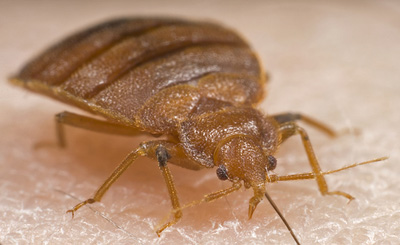About Bed Bugs

Appearance
(Adult) Almost 1⁄4” long, flat oval, light tan to mahogany colored, paper thin before feeding, engorged it may appear to be dark to bright red after feeding, 6 thin short legs, piercing-sucking mouthparts, two moderately long slender 4-segmented antennae, considered wingless however has wing stubs therefore unable to fly, can deposit between 200 to 500 eggs and produce 3 or more generation per year, known to survive over one year without feeding.
(Nymph) Tiny, almost colorless and microscopic when first hatched, resembling adult, gradually increasing in size and color through 5 molts before maturing into adult stage usually within 35 to 48 days, can survive months without feeding.
(Eggs) White, slightly curved oval shaped, size of a pin head, usually hatch within one to three weeks, sticky when first deposited, attach in crevices or rough surfaces.
Habits
Bed bugs hitchhike in luggage, cell phones, computers, clothing, diaper bags, furniture, shipping boxes, crates, etc. and on humans and animals. Bed bugs cannot fly but they are capable of moving surprisingly quickly across surfaces including ceilings, carpet, and beds, etc. During daylight hours, bed bugs hide and often commune in cracks and crevices including mattresses and bedding, bed frames, head boards and foot boards, baseboards, behind wall paper and electrical switch plates and outlets, furniture, and basically any place where they can wedge their paper thin bodies. Nocturnal and resilient, bed bugs can withstand temperatures between close to freezing up to 120 degrees Fahrenheit, they can complete development from egg to adult in as little as one month. Bed bugs are attracted to carbon dioxide, an indication of a warm-blooded body. Bed bugs emit an oily-sweet odor from thorax glands.
Feeding
Bed bugs can crawl up to 100 feet in search of its only food source – warm blood, preferably human, but they will feed on animals. Prior to feeding, saliva containing a natural anesthetic and anticoagulant is injected into the sleeping food host thereby allowing an essentially painless feeding to occur uninterrupted. Both male and female of the nymph and adult bed bugs feed on blood, and may move around several times during its 3 to 10 minute meal. After feeding, bed bugs crawl into a crack or crevice for a few days to digest. Bed bug bites can be all over the body especially in exposed areas such as face, neck shoulders, arms and hands.
Reactions
Depending on the victim’s dermal sensitivity, the bed bug bite may leave no marking at all or in some cases may leave localized swelling or itchy welts leading to scratching and the possibility of infection. Although bed bugs can harbor pathogens in their bodies, there has been no evidence to date suggesting the transmission of disease from bed bug to humans. Bed bug bites can cause sleeplessness, anxiety or stress in some people.

